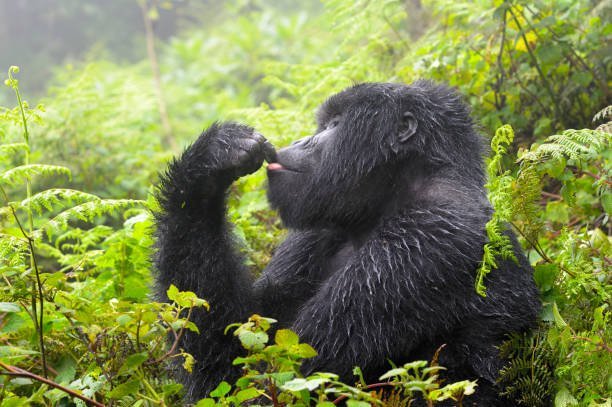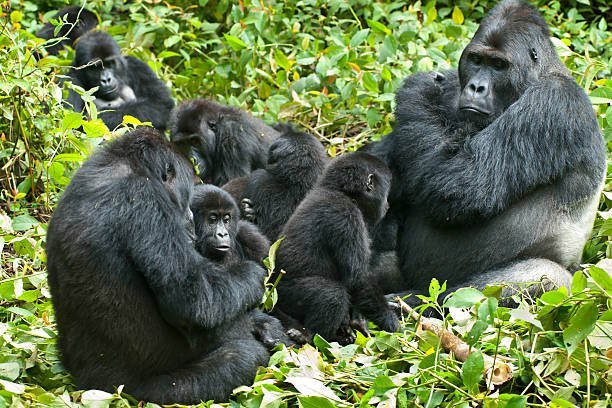Why do gorillas face threats that require rescue and conservation efforts?

Introduction:
In this article, I’ll delve into the critical issue of why gorillas face significant threats that necessitate extensive rescue and conservation efforts. Gorillas, one of our closest relatives in the animal kingdom, are under siege from a multitude of challenges that jeopardize their survival. These magnificent creatures, encompassing both Eastern and Western gorilla species, inhabit the dense rainforests and remote regions of Africa.
However, their habitats are rapidly diminishing due to deforestation, human encroachment, and the expansion of agriculture, leading to the fragmentation of their populations. Furthermore, gorillas face relentless poaching for their body parts and the illegal wildlife trade, exacerbating the already precarious situation they find themselves in. To ensure the long-term survival of gorillas and the preservation of biodiversity, concerted rescue and conservation efforts are indispensable. In the following sections, we will explore the various threats faced by gorillas and the vital measures taken to safeguard their future.
Because of habitat loss and fragmentation:
Habitat loss and fragmentation pose significant threats to gorilla populations. As human populations expand and the demand for agricultural land and natural resources increases, the forests and jungles that gorillas call home are being rapidly destroyed and divided into smaller, isolated pockets. These activities result in habitat loss and fragmentation, affecting gorilla populations in numerous ways.
First, habitat loss directly reduces the available living space for gorillas. This loss forces gorillas into smaller and more confined areas, making it challenging for them to find enough food, water, and shelter. In some cases, it may lead to overcrowding, causing increased competition for resources, which can lead to malnutrition and stress among gorillas.
Second, habitat fragmentation is equally detrimental. It isolates gorilla populations into smaller groups, making it difficult for them to interact, mate, and maintain genetic diversity. Isolated groups are more susceptible to the negative effects of inbreeding, which can result in genetic disorders and reduced fitness among offspring.
Third, habitat loss and fragmentation also expose gorillas to greater risks from external threats, such as poaching. Smaller, isolated populations are easier targets for poachers, as they are less protected and harder to monitor. In this context, rescue and conservation efforts become essential in securing and restoring gorilla habitats, along with creating corridors for safe movement between fragmented areas.
Because of human encroachment and disturbance:
Human encroachment and disturbance in gorilla habitats are major contributors to the threats facing these primates. As human populations expand and encroach upon gorilla territories, a range of issues arise that endanger gorilla populations.
First, human encroachment often leads to increased human-gorilla conflict. As humans move into previously undisturbed areas, they may compete with gorillas for resources such as food and water. This competition can lead to aggression, and in some cases, gorillas are killed as a result of these conflicts.
Second, the presence of humans in gorilla habitats can introduce diseases that are deadly to gorillas. Respiratory infections, intestinal parasites, and other diseases can be transmitted from humans to gorillas, leading to devastating outbreaks within gorilla populations.
Third, habitat disturbance by humans, including logging, mining, and infrastructure development, can disrupt gorilla habitats, making it harder for them to find food and shelter. The noise and disruption caused by these activities can also stress gorillas, impacting their overall health and well-being.
To address these threats, it is essential to implement conservation strategies that involve local communities, promote responsible tourism practices, and create buffer zones around gorilla habitats to minimize human encroachment and disturbance.
Because of illegal poaching for body parts:
Illegal poaching for gorilla body parts, such as skulls, hands, and other body parts, poses a grave threat to gorilla populations. The demand for these body parts in the illegal wildlife trade market drives poachers to target gorillas, leading to devastating consequences.
First, poaching results in the direct loss of gorilla lives. Poachers often kill gorillas to obtain valuable body parts, and in doing so, they reduce gorilla populations and disrupt social structures within groups.
Second, the poaching of gorillas has profound consequences for their genetic diversity. Killing gorillas eliminates potential breeding partners and contributes to inbreeding among surviving individuals, which can lead to a range of health issues and reduced population fitness.
Third, the illegal trade in gorilla body parts is driven by a demand for exotic souvenirs and traditional medicines. Raising awareness about the consequences of this trade and implementing stringent legal measures against poachers and traffickers is crucial for gorilla conservation.
Rescue and conservation efforts must focus on not only protecting gorillas from poaching but also on addressing the root causes of poaching, such as poverty and lack of education in local communities, to ensure the long-term survival of these magnificent creatures.
Because of the illegal wildlife trade:
The illegal wildlife trade is a pervasive and destructive threat to gorilla populations, causing harm in various ways. This trade involves the capture, transport, and sale of gorillas and their body parts on the black market, primarily for purposes of pets, trophies, and traditional medicine.
First and foremost, gorillas are captured and trafficked, causing significant declines in their populations. The illegal wildlife trade targets gorillas as commodities, separating them from their natural habitats and social groups, leading to a dramatic reduction in their numbers.
Second, the trade negatively impacts gorillas’ physical and psychological well-being. They are subjected to harsh and inhumane conditions during transportation and captivity, resulting in severe stress and often physical injuries. The living conditions in captivity are far from suitable for these highly intelligent and social creatures.
Third, the illegal wildlife trade exacerbates other threats such as poaching and habitat loss. The financial incentives for traffickers drive poaching and create further demand for habitat conversion.
Efforts to combat the illegal wildlife trade must involve law enforcement, international cooperation, and public awareness campaigns to reduce demand. Additionally, rehabilitating and reintroducing confiscated gorillas back into the wild is an essential part of rescue and conservation initiatives.
Because of diseases and health challenges:
Gorillas face various diseases and health challenges, both natural and human-induced, that impact their populations negatively.
First, infectious diseases can decimate gorilla communities. Diseases like Ebola, respiratory infections, and parasites are known to infect and kill gorillas. These diseases can spread rapidly within populations due to the close social bonds and interactions among group members.
Second, human-introduced diseases pose a severe threat. Gorillas can contract diseases from humans through close proximity, such as tourism or research activities. Diseases that are relatively harmless to humans can be deadly for gorillas, as they have not developed immunity to these pathogens.
Third, habitat disruption can also contribute to health challenges. Stress, malnutrition, and reduced access to clean water can weaken gorillas’ immune systems, making them more susceptible to diseases.
To mitigate these health challenges, rescue and conservation efforts should involve regular health monitoring of gorilla populations, habitat protection to reduce stressors, and responsible tourism practices that minimize the risk of disease transmission.
Because of political instability in their habitats:
Political instability in the regions where gorillas live can have a detrimental impact on conservation efforts.
First, instability can disrupt conservation programs and impede the ability to protect gorilla populations effectively. Conservation organizations may struggle to gain access to critical areas and establish protective measures during times of political turmoil.
Second, instability can lead to increased poaching, as law enforcement efforts may be compromised or weakened. Poachers may take advantage of chaotic situations to exploit gorillas.
Third, local communities and government agencies may prioritize immediate political and economic concerns over gorilla conservation during unstable periods, diverting resources and attention away from protection efforts.
To address this challenge, international cooperation and diplomatic efforts are necessary to promote stability and ensure the safety of gorilla populations in politically volatile regions.
Because of climate change and environmental degradation:
Climate change and environmental degradation pose growing threats to gorilla habitats and populations.
First, climate change can disrupt the ecological balance of gorilla habitats, affecting the availability of food and water. Altered weather patterns can lead to periods of drought or increased rainfall, making it harder for gorillas to find reliable sources of nourishment.
Second, environmental degradation, including deforestation and habitat loss, exacerbates the impact of climate change. Reduced forest cover leads to changes in temperature and humidity, further challenging the adaptability of gorillas.
Third, extreme weather events, like storms and floods, can damage gorilla habitats and disrupt their day-to-day lives. These events can have severe consequences for gorilla communities and their overall well-being.
Rescue and conservation efforts must address the consequences of climate change and focus on habitat restoration, afforestation, and climate-resilient conservation strategies to protect gorillas from these environmental challenges.
Because of lack of awareness and education:
A critical challenge in gorilla conservation is the lack of awareness and education, both locally and globally.
First, local communities living near gorilla habitats may not fully understand the importance of gorilla conservation or may have limited access to educational resources. This lack of awareness can lead to apathy or even hostility towards conservation efforts.
Second, tourists and the general public may not be aware of the impact of their actions on gorillas, such as the potential transmission of diseases during tourism encounters or the consequences of supporting the illegal wildlife trade.
Third, international awareness and support for gorilla conservation efforts may be inadequate, hindering the availability of necessary resources and funding.
To address this issue, education and awareness campaigns are essential. These initiatives should target local communities, tourists, and the broader public, emphasizing the importance of gorilla conservation and responsible practices when visiting gorilla habitats. Additionally, international organizations and governments should actively promote gorilla conservation and allocate resources to support these efforts.
Conclusion:
I hope this exploration of the multifaceted threats faced by gorillas and the imperative need for rescue and conservation efforts has shed light on the urgent action required to ensure the survival of these magnificent creatures. Gorillas, our closest relatives in the animal kingdom, confront a daunting array of challenges, including habitat loss, poaching, diseases, and the illegal wildlife trade, exacerbated by political instability, climate change, and a lack of awareness.
In the face of these threats, dedicated conservationists, local communities, and international organizations are working tirelessly to protect and rehabilitate gorilla populations. The importance of habitat preservation, law enforcement against poaching and trafficking, healthcare for gorillas, and community engagement cannot be overstated. Additionally, public awareness and support play a crucial role in fostering empathy for these remarkable animals. Together, we must continue our collective efforts to ensure a brighter future for gorillas and uphold our responsibility to safeguard the biodiversity of our planet. It is only through sustained commitment and cooperation that we can secure the well-being of gorillas and their vital role in the ecosystems they inhabit.










Post Comment